The first day of another long weekend of Autumn tours today. We met in Wells and made out way east to explore the coast, looking for migrants. It was a lovely warm and mostly sunny day, with light winds – a great day to be out.
We started at Warham Greens. The trees were damp and it was still a bit cool as we walked along Garden Drove first thing. We came across several Goldcrests in the trees as we made our way down, fluttering in amongst the trees, feeding continuously and calling.
There were lots of Chaffinches in the hedges either side as well. Finches of various types have been on the move in recent weeks. The impressive Siskin passage we had seen has now died down, but we still had a couple of Siskin fly in calling and circle round over the lane with the Chaffinches. A couple of Redpoll flew over calling as well. Down along the front, we made our way along to the westernmost pit. As we walked along, we flushed a couple of flocks of Greenfinch and Goldfinch from the bushes.
Scanning the saltmarsh, the first thing we noticed was a large dark shape sat atop a bush way off in the distance. A quick look through the scope confirmed it was a Marsh Harrier, dark bodied and with a pale head which really stood out in the morning light. It flew off to the east, patrolling along the edge of the beach. Then an altogether smaller, slimmer winged raptor appeared low over the saltmarsh. We could see the small square white patch at the base of the tail as it turned, a ringtail Hen Harrier.
 Hen Harrier – quartering the saltmarsh off Warham Greens
Hen Harrier – quartering the saltmarsh off Warham Greens
We watched it hunting over the saltmarsh, working its way steadily towards us. It made its way in a little further over towards Wells, flying up over the hedge and disappearing inland over the fields beyond.
We made our way back and had a look in the trees at the north end of Garden Drove, but it was quiet in there this morning, even on the sunny east edge. A flock of tits made its way along the hedge from the direction of Wells. There were only five Long-tailed Tits in this group, so it was not the bigger flock which sometimes roams around the area. We had a close look, as a Yellow-browed Warbler had been with tits here yesterday, but there was nothing of note with these ones.
We had hoped we might pick up a Ring Ouzel here, but another birder arriving from the east told us there was nothing around the main pit, but that he had flushed two Ring Ouzels from the hedge close to Stiffkey. We decided to try there instead – we could have a look in the campsite wood while we were there. A Blackcap in the hedge was a nice addition to the day’s list as we walked back up the track.
From the carpark at Stiffkey, we walked west along the coast path. Unfortunately, there were lots of dog walkers out now that it had warmed up a little and there was lots of disturbance. As a consequence, it was not a great surprise that there was no sign of the Ring Ouzels. We did come across another tit flock working its way noisily along the hedge – with many more Long-tailed Tits in this one, but nothing of note. There were also more flocks of Greenfinch and Goldfinch. Out on the saltmarsh, we could see a mass of Golden Plover and several Curlew, remarkably well camouflaged down in the vegetation. There are lots of Brent Geese in now, feeding out on the saltmarshes.
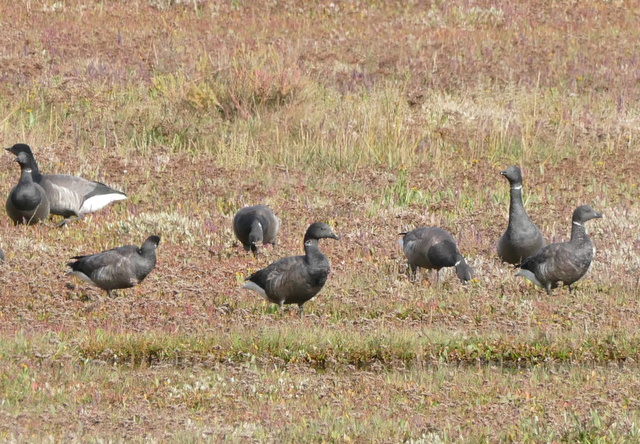 Brent Geese – feeding on the saltmarsh grasses when they first return
Brent Geese – feeding on the saltmarsh grasses when they first return
We walked back to the car and into the campsite wood just beyond. There had been a Yellow-browed Warbler in the trees here earlier in the week, but with a lot of birds moving on in recent days, we were not expecting anything to still be here. As we walked in through the trees, the sycamores were full of Chaffinches. In the first little stretch, where the trees are more open, we found several tits feeding in the sunshine as well – Blue Tits, Great Tits and a Coal Tit – plus more Goldcrests. There was a lot of activity in this bit of the wood.
We continued to work our way along through the trees, but once they closed in so the sunlight couldn’t really penetrate it became increasingly quiet. We turned round and started to walk back, and realised that there were now Long-tailed Tits in the trees as well. As we scanned the sycamores, we glimpsed the slimmer, sleeker outline of a warbler ahead of us and a quick look confirmed it was a Yellow-browed Warbler.
We walked quickly back to where the Yellow-browed Warbler had been feeding, but at first we couldn’t see it again. Then we picked it up in a sunny gap in the treetops and we all had a really good look at it – we could see its bright yellowish-white brow and double wingbar. It disappeared a couple of times, but we managed to pick it up again, before we lost sight of it. It called briefly ahead of us somewhere in the tops of the trees, but we couldn’t see it. Still, it was a hoped for but unexpected bonus to find it in here today. While we were looking for it, a Chiffchaff appeared in the treetops as well.
We had been planning to make our way towards Cley today, but with reports of a Pectoral Sandpiper there, we decided to head on further east. We parked at Walsey Hills and walked over to the East Bank. The path along the bank is currently being resurfaced – it was supposed to be finished a week ago but the fences were still up and the diversion along the lower edge still in place. We saw the workmen doing a lot of chatting, but not much work – perhaps that is why it is behind schedule!
 Ruff – there were lots feeding on the flooded grazing marshes
Ruff – there were lots feeding on the flooded grazing marshes
The grazing marshes towards Pope’s Marsh and around the Serpentine are full of water at the moment and look really good for birds. We were distracted from our quest and spent some time scanning through the flocks of waders and ducks. There were lots of Ruff feeding close to the bank – adults with brighter white underparts and increasingly faded juveniles. A flock of smaller waders whirled round – Dunlin and Snipe.
There were good numbers of ducks as well. Mainly Wigeon and Teal, mostly still in duller eclipse plumage, but the occasional male starting to show more advanced signs of moulting back into breeding plumage. Scanning through the hordes, we found a couple of Pintail and a single moulting drake Shoveler as well.
As we turned right along the base shingle ridge, a Wheatear flicked along the grassy bank. It stood there eyeing us warily as we passed. A little further along, a second Wheatear sat preening on a fence post. There were a couple of people stood on the shingle ridge as we arrived at the spot where the Pectoral Sandpiper had been seen, overlooking Wigeon Marsh. They didn’t seem particularly sure what they were looking at, but when we got our scopes onto it we could see that it was indeed the Pectoral Sandpiper. Great! It was feeding on a grassy spit with a little group of Snipe.
 Pectoral Sandpiper – looking into the sun from the shingle ridge
Pectoral Sandpiper – looking into the sun from the shingle ridge
Unfortunately, just as we got everyone onto it, the Snipe were spooked and all the waders took to the air. The Snipe seemed to forget their panic pretty quickly and landed straight back down where they had been, but we watched the Pectoral Sandpiper flying way off towards Salthouse, where it appeared to drop down somewhere near the Iron Road. Typical! At least we had all seen it.
We spent a few minutes scanning the sea behind us and the waders on Arnold’s Marsh. There was a large flock of Golden Plover out there, bathing and preening. We could also see a few Black-tailed Godwit, Dunlin, Curlew and Redshank. After a few minutes, we looked back to the spit where the Pectoral Sandpiper had been only to find that it had sneaked back in unseen and was feeding back pretty much exactly where it had been. We were looking into the sun, but we could see its streaked breast and white belly, with the pectoral band forming the sharp divide between the two.
It was time to head back for lunch, so we walked back towards the East Bank. We were rather easily distracted, which delayed our progress. There were a few Gannets passing by distantly offshore, mostly slate-grey juveniles. Two darker, blackish shapes flying east right out by the wind turbines stood out because of the way they flying – steady, deep wingbeats. A look through the scope confirmed they were a couple of Great Skuas, or Bonxies, making their way along the coast. We could just make out the white wing flashes.
 Wheatear – this very obliging bird was feeding along the East Bank
Wheatear – this very obliging bird was feeding along the East Bank
The Wheatears we had seen on the walk out had seemed rather wary, but as we turned to walk back along the East Bank, we could see a little phalanx of photographers edging their way towards us. A Wheatear was hopping along the path just in front of them. We stopped and let them push it towards us. It seemed incredibly tame – it kept coming until it was only a few metres away. Great views.
The other side of the East Bank, the Little Egret was feeding in its usual place on the edge of the brackish pools. Presumably the same bird, it has been on exactly the same pool just below the path every time we have been here recently.
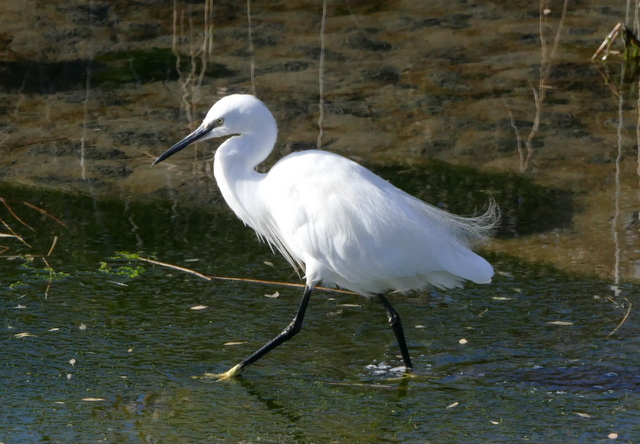 Little Egret – in its usual place, just off the East Bank
Little Egret – in its usual place, just off the East Bank
After the distractions on the way back, it was a late lunch for us back at the picnic tables at the Visitor Centre. We could see that Pat’s Pool was very full with water, so we didn’t venture out onto the reserve afterwards, but headed round to the beach car park instead. We had hoped that the Snow Bunting might still be around, but we couldn’t find it. North Scrape was also full of water. A scan of the sea from here revealed a brief Guillemot, which dived and could to be relocated, and a smart Red-throated Diver, still mostly in summer plumage. We could see its red throat as it turned in the sunshine.
Our last stop was at Kelling. With the wind having swung round to the east, we thought it might be a good place to look for migrants. There were lots of Chaffinches in the lane on the way down – a recurring theme today – but the trees around the copse were quiet, despite the warm afternoon sunshine and lots of insects. A Migrant Hawker dragonfly was basking in the sun on the brambles beside the path.
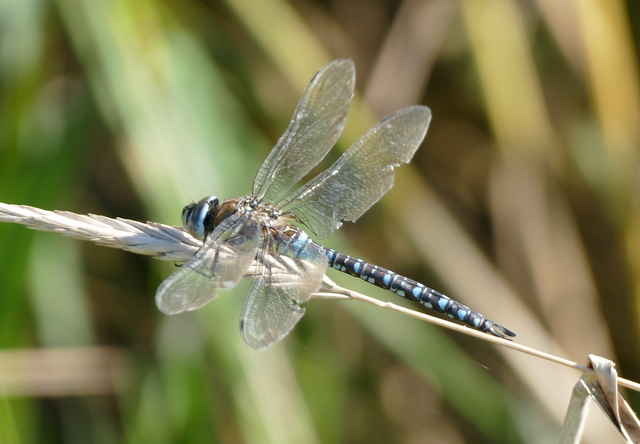 Migrant Hawker – one of the late dragonflies, still on the wing
Migrant Hawker – one of the late dragonflies, still on the wing
The Water Meadow itself was fairly quiet. The pool here fills up with water quickly at this time of year. A handful of Wigeon, Teal and Shoveler seemed to be enjoying it. Beyond, on the Quags, the resident pair of Egyptian Geese were walking about on the grass. A Little Egret was feeding unobtrusively in one of the muddy drainage channels.
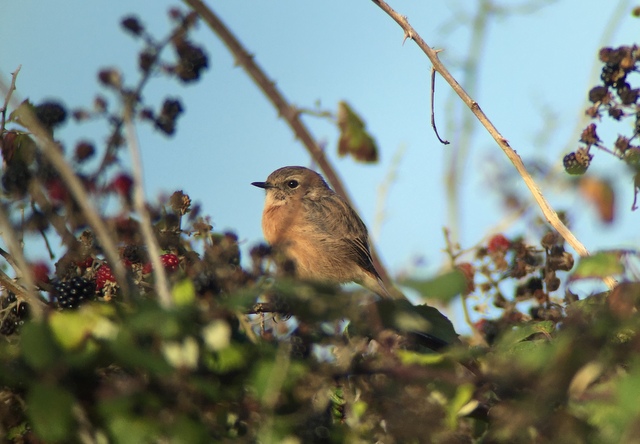 Stonechat – there were several birds around the Quags today
Stonechat – there were several birds around the Quags today
Down around the Quags, we found several Stonechats. This is one of the few places they have bred along the coast in the last couple of years and the resident birds seem to be bolstered by immigrants at this time of year. Otherwise, all we could find were Linnets, Goldfinches and Meadow Pipits by the path. Finally, we turned to head back and walked up along the lane to the sound of Pink-footed Geese passing overhead – presumably birds heading down to the Broads.
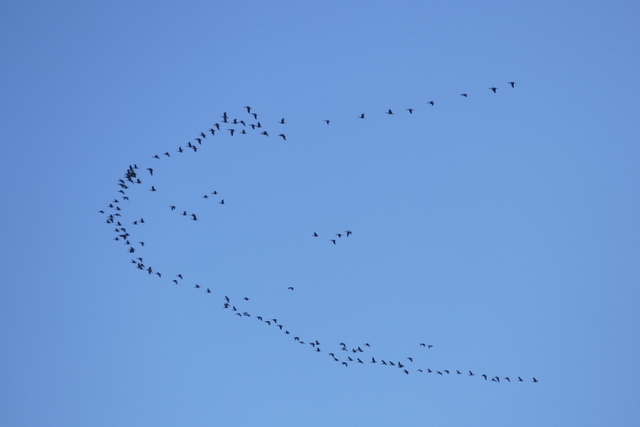 Pink-footed Geese – a skein over Kelling, probably on its way to the Broads
Pink-footed Geese – a skein over Kelling, probably on its way to the Broads
















